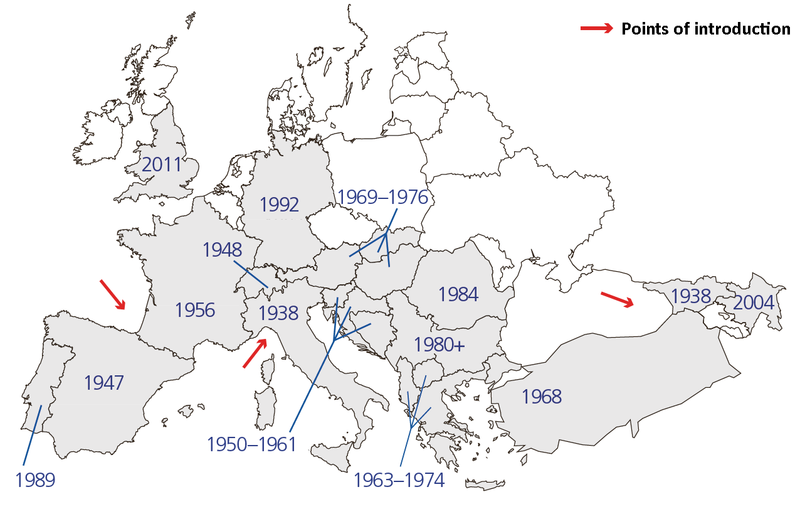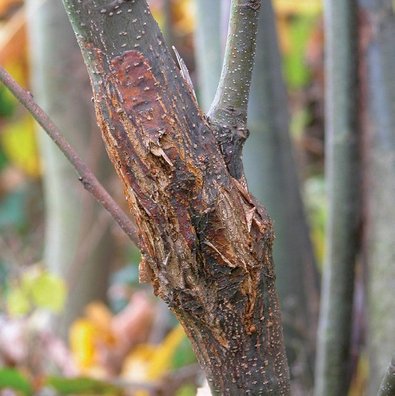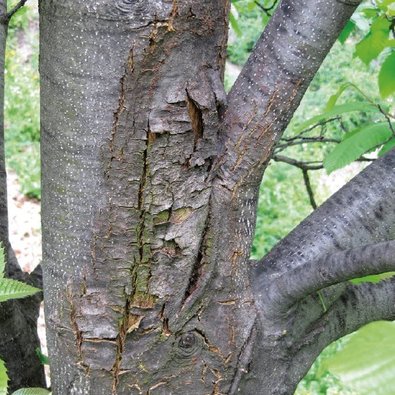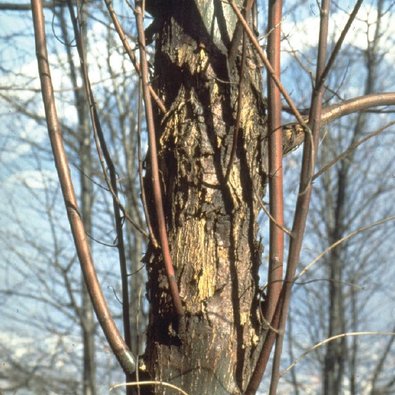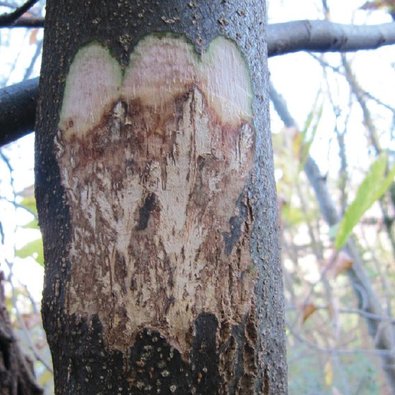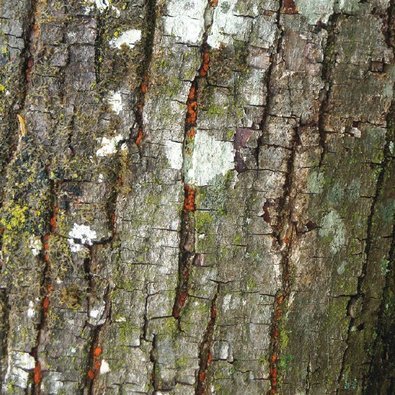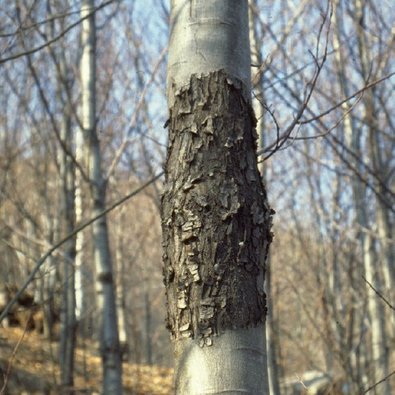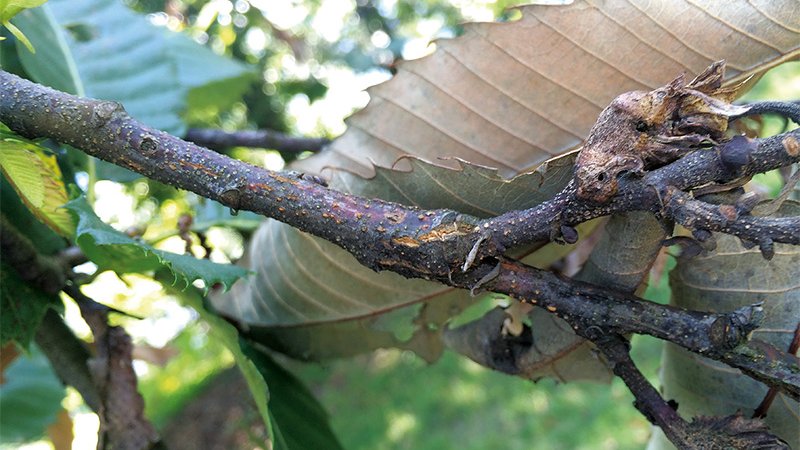Chestnut blight is caused by the fungus Cryphonectria parasitica (formerly known as Endothia parasitica). The pathogen originates from East Asia, where it occurs as a weak parasite on the resistant Japanese (Castanea crenata) and Chinese chestnut (Castanea mollissima). In the early 20th century, the fungus was accidentally introduced into the USA with infected plant material, triggering a dramatic epidemic that almost completely eradicated the extensive forests of American chestnut (Castanea dentata) in the eastern USA.
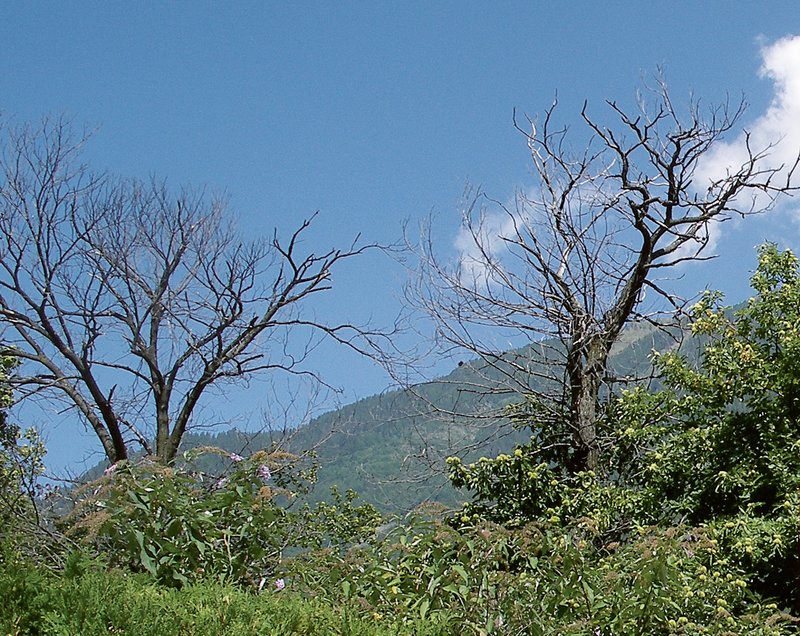
Fig. 1. Chestnut trees infected with chestnut blight near Collonges (Valais). After a long-standing infection, a large portion of the crown has died off. Photo: Phytopathology WSL
In 1938, this dangerous tree disease was also discovered in Europe, in the hinterland of Genoa, whence it quickly spread through Italy and neighbouring countries. The first recorded occurrence of chestnut blight in Switzerland was in Ticino in 1948. Today almost all chestnut stands in Europe are affected by the disease (see fig. 2).
Mild disease impact thanks to hypovirulence
Unlike in the USA, the impact of the disease in Europe has been less dramatic. On the one hand, the European chestnut (Castanea sativa) is slightly less susceptible to the pathogen than the American chestnut; on the other hand, strains of the fungus showing a reduced virulence appeared in Europe. These hypovirulent fungal strains spontaneously spread south of the Alps along the northern Mediterranean, thus preventing the destruction of local chestnut forests. Thanks to natural hypovirulence, the survival of the chestnut in southern Switzerland is not under threat anymore.
Since the 1980s, chestnut blight has also been found in chestnut stands north of the Alps in Switzerland. Genetic analyses have shown that in most cases the pathogen was introduced from south of the Alps. In contrast to there, no hypovirulent strains of the fungus appeared spontaneously in C. parasitica populations north of the Alps. However, in the meantime targeted treatment of the disease over many years has also established hypovirulence in many chestnut stands north of the Alps.
Virulence = the extend to which a pathogen can cause a disease in a susceptible host
Hypovirulence = reduced virulenceFind out more about hypovirulence in the extensive WSL information sheet (PDF, in German)
Symptoms of the disease
Cryphonectria parasitica infects the bark of stem and branches of its host trees. At the point of infection, the bark turns red (fig. 3), sinks inwards and later on cracks (fig. 4). In response, the tree attempts to cover the destroyed tissue and so-called bark cankers develop. As soon as a bark canker has girdled the entire branch or stem, the plant part above the point of infection dies. The leaves wilt, but do not fall. Wilted leaves during the growing season or brown hanging leaves in winter are a typical sign of chestnut blight that is visible from a long way off.
Below the bark cankers infected trees usually produce epicormic shoots (fig. 5). The fungus forms pale brown mycelial fans in the bark and cambium, which are a dependable sign of an infection (fig. 6). Finally, small yellow-orange to red fruiting bodies develop on the dead bark or in bark cracks (fig. 7). Hypovirulent strains of C. parasitica grow in the outer bark, producing only superficial cankers, which heal rapidly. Typically, many of these healed superficial cankers are blackish in colour (fig. 8).
Since the chestnut gall wasp (Dryocosmus kuriphilus) spread across Europe, more and more small dead branches or shoots have been observed in the crowns of chestnut trees. In most instances, this new symptom of infection is caused by interplay between the gall wasp and chestnut blight, since the fungus often penetrates and kills small branches through galls abandoned by the wasp (fig. 9).
Measures
- C. parasitica is a quarantine organism listed in the Swiss Federal Plant Protection Ordinance (SR 916.20). Since the pathogen is frequently spread via plant material, the first thing to do is to regulate this pathway of spread. For this reason, trade in chestnut - and to some extent oak - material is subject to special regulations that apply worldwide. Chestnut fruits are exempted from these regulations.
- In regions free of chestnut blight, new disease outbreaks should be swiftly eradicated. Infected trees are to be removed or, if possible, pruned to leave only the healthy parts. Any sawn timber is either to be burnt in situ or taken to an incineration facility. In infected chestnut stands, the regular removal of virulent cankers reduces the disease incidence. All tools used when working on diseased chestnut trees or in infested chestnut stands must subsequently be disinfected.
- If chestnut blight is already widespread throughout a chestnut stand, its eradication is no longer a realistic prospect. In this case, one possibility is to actively control the disease biologically, using hypovirulent fungal strains. This entails treating bark cankers with virus-infected, hypovirulent strains of C. parasitica.
Resistant chestnut trees
Several hybrid chestnuts available on the market display a certain resistance to chestnut blight. Most such hybrids are crosses between European and Japanese chestnuts. Most of the varieties on sale in nurseries are French hybrids. Three additional varieties – Brunella, Marowa and Golino – are the result of a breeding programme in Switzerland. These varieties are suited for cultivation north of the Alps in warm locations with acid soils.
Translation : TTN Translation Network

